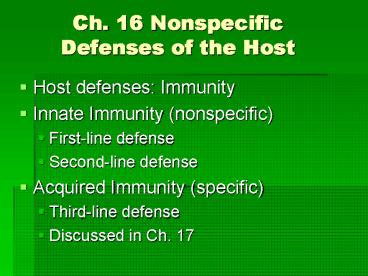Host defenses: Immunity - PowerPoint PPT Presentation
1 / 25
Title:
Host defenses: Immunity
Description:
Ciliary escalator: Microbes trapped in mucus are transported away ... Microbial synergism: Microbial commensalism: Microbial antagonism: Second-line defense ... – PowerPoint PPT presentation
Number of Views:68
Avg rating:3.0/5.0
Title: Host defenses: Immunity
1
Ch. 16 Nonspecific Defenses of the Host
- Host defenses Immunity
- Innate Immunity (nonspecific)
- First-line defense
- Second-line defense
- Acquired Immunity (specific)
- Third-line defense
- Discussed in Ch. 17
2
First-line Defense
- Mechanical Factors
- Chemical Factors
- Normal flora
3
Mechanical Factors
- Skin
- Epidermis consists of tightly packed cells
- Keratin, a protective protein
- Mucous Membrane
- Ciliary escalator Microbes trapped in mucus are
transported away from the lungs - Urine and vaginal secretions Flows out
- Glands
- Lacrimal apparatus Washes eye
- Saliva Washes microbes off
4
Chemical Factors
- Sebaceous glands of skin secrete sebum Fatty
acids w/ pH of 3-5 - Gastric juices of stomach acidic pH (1.2-3)
- Perspiration, tears, saliva, and tissue fluids
secrete lysozymes and peroxidase enzymes - Transferrins in blood compete with bacteria for
the binding of iron - Nitric oxide (NO) inhibits ATP production of
bacteria
5
Normal Flora
- Microbial synergism
- Microbial commensalism
- Microbial antagonism
6
Second-line defense
- White Blood Cells
- Granulocytes
- Mononuclear Phagocytes (monocytes)
- Lymphocytes
- Phagocytosis
- Other Blood Components
- Inflammation fever
- Complement system
- Lymphatic System
7
Formed Elements in Blood
8
White Blood Cells
- Neutrophils Phagocytic
- Basophils Produce histamine
- Eosinophils Toxic to parasites, some
phagocytosis - Monocytes Phagocytic as mature macrophages
- Fixed macrophages in lungs, liver, bronchi
- Wandering macrophages roam tissues
- Lymphocytes Involved in specific immunity
9
Differential WBC count
Percentage of each type of white cell in a sample
of 100 white blood cells
Percentage of each type of white cell in a sample
of 100 white blood cells
Percentage of each type of white cell in a
sample of 100 white blood cells
10
Phagocytosis
- Neutrophils
- Macrophages
- Produce cytokines
- Interact with T helper cells activated
macrophages - Help form granulomas
- Process of phagocytosis
11
Process of phagocytosis
Figure 16.8a
12
Microbial Evasion of Phagocytosis
13
Other Blood Components
- Red Blood Cells, Platelets, Plasma
- Important role in inflammatory response
- Major function is blood clotting
- Serum
- Clear yellowish fluid that contains proteins
- Albumin
- Globulin gamma portion contains antibodies
- Complement system
- Interferons glycoproteins
14
Inflammation
- Cardinal signs Redness, Pain, Heat, Swelling
(edema) - Complement cascade (acute-phase proteins
activated cytokine, kinins) - Vasodilation (histamine, kinins, prostaglandins,
leukotrienes) - Margination and emigration of WBCs
- Tissue repair
15
Chemicals Released by Damaged Cells
16
Inflammation process
Figure 16.9a, b
17
Inflammation process
Figure 16.9c, d
18
Fever
- Physiological response to infections
- Pyrogens
- Endogenous fever-inducing cytokines
- Exogenous bacterial endotoxins
- Hypothalamus controls temperature
- releases prostaglandins that reset the
hypothalamus to a high temperature - Body increases rate of metabolism and shivering
to raise temperature - High temperature inhibits pathogen growth
19
The Complement System
- Serum proteins activated in a cascade.
- Complement activation
- Classical
- Alternative
- Lectin
Figure 16.10
20
Classical Pathway
Figure 16.13
21
Alternative Pathway
Figure 16.14
22
Lectin Pathway
Figure 16.15
23
Interferons (IFNs)
- Alpha IFN Beta IFN Cause cells to produce
antiviral proteins that inhibit viral replication - Gamma IFN Causes neutrophils and macrophages to
phagocytize bacteria
24
Interferons (IFNs)
New viruses released by the virus-infected host
cell infect neighboring host cells.
5
2
The infecting virus replicates into new viruses.
AVPs degrade viral m-RNA and inhibit protein
synthesis and thus interfere with viral
replication.
6
Viral RNA from an infecting virus enters the cell.
1
The infecting virus also induces the host cell to
produce interferon on RNA (IFN-mRNA), which is
translated into alpha and beta interferons.
3
Interferons released by the virus-infected host
cell bind to plasma membrane or nuclear membrane
receptors on uninfected neighboring host cells,
inducing them to synthesize antiviral proteins
(AVPs). These include oligoadenylate synthetase,
and protein kinase.
4
Figure 16.16
25
Lymphatic System
- Lymphatic vessels
- 1º lymphoid organs
- Thymus
- Bone marrow
- 2º lymphoid organs
- Lymph nodes
- Adenoids
- Tonsils
- Spleen
- Appendix
- SALT
- MALT































